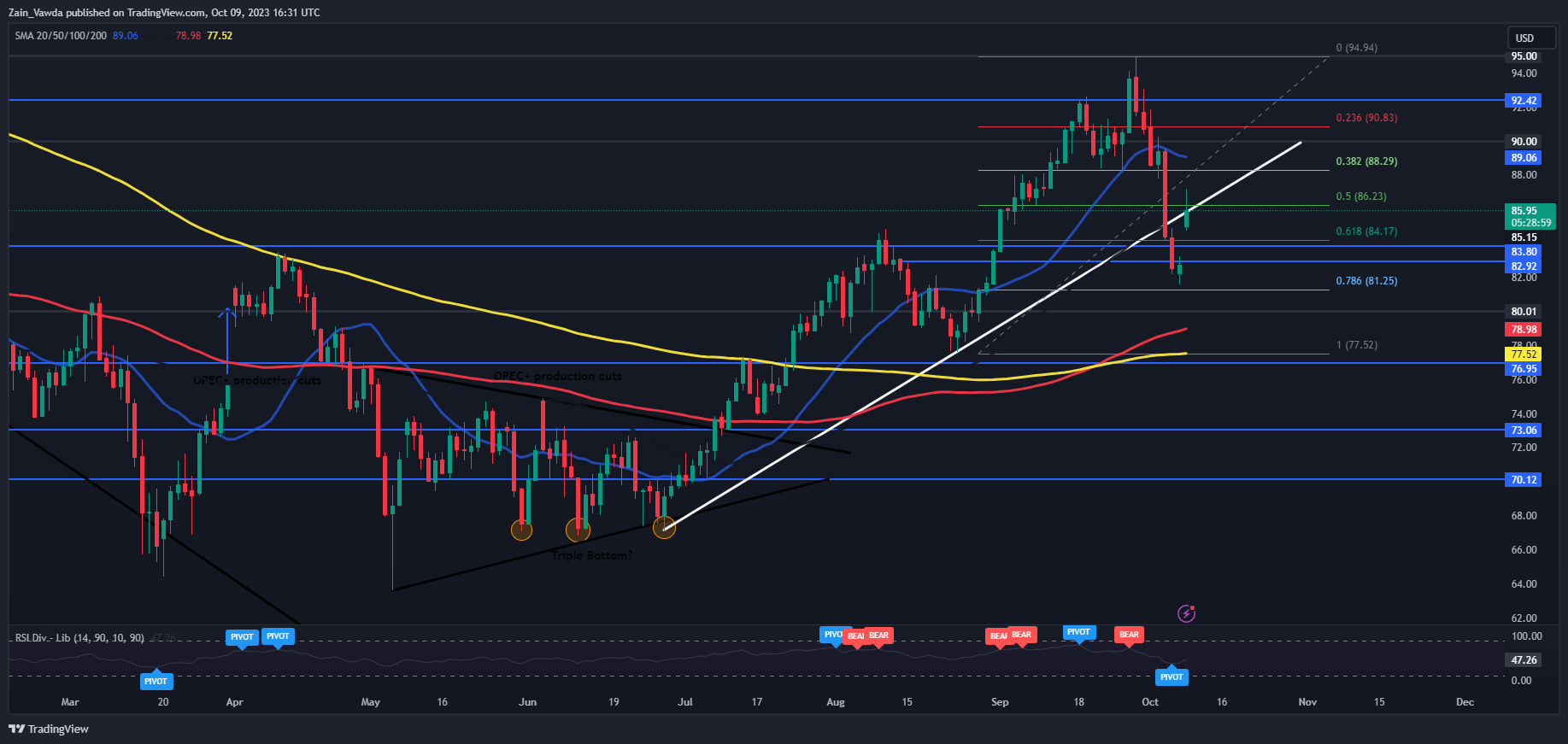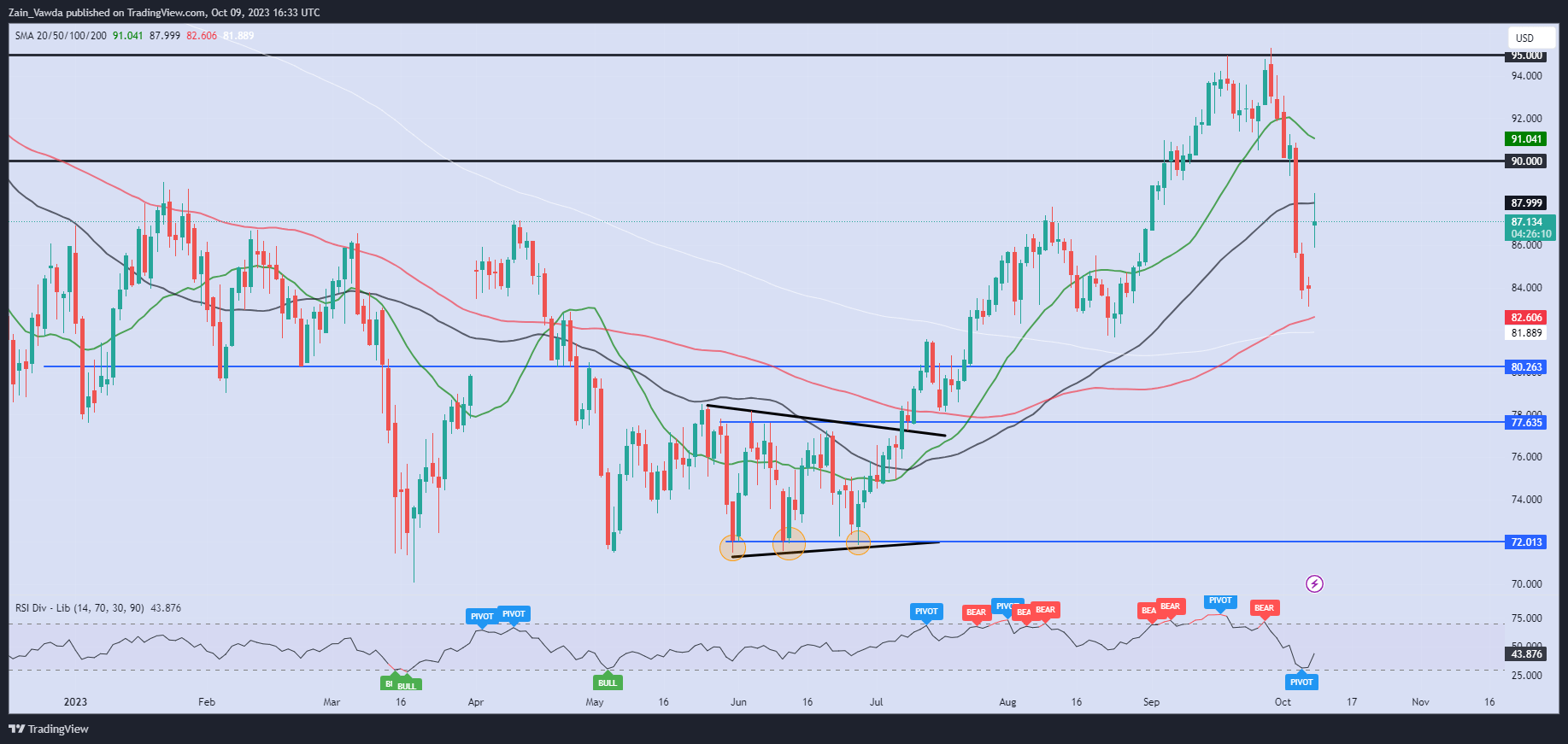OIL PRICE FORECAST:Most Read: What is OPEC and What is Their Role in Global Markets?Oil prices have held relatively steady through the European sessio
OIL PRICE FORECAST:
Most Read: What is OPEC and What is Their Role in Global Markets?
Oil prices have held relatively steady through the European session following the gap in prices over the weekend. WTI closed last week at $82.74 a barrel before opening last night around the $85.00 a barrel mark as the turmoil between Israel and Palestine intensified.
Elevate your trading skills with an extensive analysis of Oils prospects, incorporating insights from both fundamental and technical viewpoints. Download your free Q4 guide now!!
Recommended by Zain Vawda
Get Your Free Oil Forecast
MIDDLE EAST SPILLOVER AND WHAT IT WOULD MEAN FOR OIL PRICES?
The selloff in oil last week was welcomed by Central Banks and consumers alike as fears around a rise in inflation took a back seat. The start to the week however may re-ignite these fears as Oil is now trading back above the $86 a barrel mark. Market participants appear concerns by the prospect of a spillover from the Israel- Palestine conflict to the rest of the Middle East. This is largely down to ongoing rhetoric and public discourse speculating on Iran’s involvement, something which to now World Leaders have not commented on.
Israel who has been in negotiations with Saudi Arabia to normalize relations last week has said they would not like to jeopardize negotiations while promising that the Israeli response will change the face of the Middle East. Market participants did fear the worst from Saudi Arabia and OPEC with a potential embargo viewed as the worst-case scenario.
OIL EMBARGO 1973, A RE-RUN OR COMPLETELY DIFFERENT SITUATION?
For those who like me are born after 1973, we are not familiar with Oil embargo imposed by Saudi Arabia and OAPEC (Arab members of the Organisation of Arab Petroleum Exporting Countries).
The oil embargo initiated by Saudi Arabia, along with other Arab members of the Organization of Arab Petroleum Exporting Countries (OAPEC), began on October 17, 1973. This event is commonly referred to as the “1973 oil crisis” or the “Arab oil embargo.” The embargo was a response to the support provided by Western countries, particularly the United States, to Israel during the Yom Kippur War, which began on October 6, 1973. The oil embargo resulted in significant disruptions to oil supplies worldwide and had a profound impact on global energy markets.
Market participants had feared the potential of a similar outcome but the current dynamics between the US and Saudi are different. The current negotiations between the Saudi’s and Israel around normalizing relations remains up in the air but looking positive as the US would agree to a defense deal with the Kingdom in exchange.
The first comments from the Saudi regime also stuck to the old rhetoric of two-state solution and called for an end to the violence which by now has become the go to comments in the Israel-Palestine conflict.
The more realistic option at this stage remains tighter sanctions on Iranian Oil as we have seen rhetoric ramped up in some quarters blaming the current Iranian Regime for orchestrating such attacks. Iran has recorded a production increase over the past 12 months to about 600k barrels a day and have also been selling some of its stockpiles both on and offshore, which had kind of offset the cuts by Russia and Saudi Arabia. Will the West impose tougher sanctions on Iran?
Looking for the best trade ideas for Q4? Look no further and download your complimentary guide courtesy of the DailyFX team of Analysts and Strategists.
Recommended by Zain Vawda
Get Your Free Top Trading Opportunities Forecast
OPEC ANNUAL FORECAST
OPEC today raised its demand forecast for the medium and long-term in an annual outlook. The organization stated around $14 trillion of investment may be needed to meet the demand and confirmed that it sees demand going higher than it perceived before the Pandemic. The group also doubled down on its belief that Oil should form a part of the energy transition otherwise we are in for a energy and economic chaos.

Source: Refinitiv
RISK EVENTS AHEAD
US inflation data was supposed to be the driving force for markets this week but is now likely to be overshadowed by the Geopolitical tensions. Little on the docket from the US tomorrow with PPI and the FMC minutes on Wednesday, developments around Israel-Palestine could continue to be a catalyst and drive the market mood and risk appetite.

For all market-moving economic releases and events, see the DailyFX Calendar
TECHNICAL OUTLOOK AND FINAL THOUGHTS
From a technical perspective both WTI and Brent have opened higher overnight and continued their advance before a slight lull and wait and see approach in the US session saw a slight pullback.
I would personally like to see the gap close, however last time Oil gapped up quite a bit it took around 20 days for it to finally close the gap. History to repeat itself?
WTI Crude Oil Daily Chart – October 9, 2023

Source: TradingView
Key Levels to Keep an Eye On:
Support levels:
- 81.25
- 80.00
- 78.98 (100-day SMA)
Resistance levels:
- 87.00
- 88.30
- 90.00 (psychological level)
Brent Crude continues to look like a mirror image of WTI with the 14-day RSI finally giving Brent some impetus to rally higher. Brent has run into a spot of bother though finding resistance around the 88.00 mark which lines up with 50-day MA.
Brent Oil Daily Chart – October 9, 2023

Source: TradingView
IG CLIENT SENTIMENT
IG Client Sentiment data tells us that 72% of Traders are currently holding LONG positions.
| Change in | Longs | Shorts | OI |
| Daily | 19% | 15% | 18% |
| Weekly | 100% | -41% | 21% |
Written by: Zain Vawda, Market Writer for DailyFX.com
Contact and follow Zain on Twitter: @zvawda
element inside the
element. This is probably not what you meant to do!Load your application’s JavaScript bundle inside the element instead.
www.dailyfx.com

COMMENTS